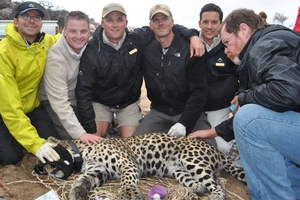Two Cape leopards have been caught and collared with highly sophisticated Iridium satellite collars for research purposes in the Bushmans Kloof Wilderness Reserve in the Cederberg, by Dr Quinton Martins and his team from the Cape Leopard Trust (CLT).
Bushmans Kloof Wilderness Reserve & Wellness Retreat has been a major sponsor of The Cape Leopard Trust since its inception nine years ago. The project launched in August 2004 as an active predator conservation working group in the Cape, using research as a tool for conservation, finding solutions to human-wildlife conflict, and inspiring interest in the environment through an interactive and dynamic environmental education programme. Over 20 leopards have been collared since then, four of them at Bushmans Kloof, forming part of a long term research and monitoring project.
Recent focus has been on the leopards’ breeding and sub adults dispersing behaviour. Although the CLT was fortunate enough to monitor leopard denning behaviour in 2010, this is the first time that a pregnant leopard has been captured in the Cederberg wilderness area. Dr Martins believes that monitoring the pregnant female and her cubs after they are born, could lead to significant new research results about the behaviour of this enigmatic species.
Considerable effort is taken to ensure the safety of the animal when caught. Traps are monitored every couple of hours and response time is kept to an absolute minimum.
Caught on 8 September 2013, the female leopard Crystal was named after the nearby Crystal Pools in the Bushmans Kloof reserve. It is believed that the she is due to give birth within the next few weeks.
A week later, a second leopard, named M18 for the time being, was caught in the same area. Weighing in at 57.5kg, an impressive size compared to the average weight of around 34kg of adult male leopards in the area, he is by far the biggest male leopard ever recorded by the Cape Leopard Trust in the Western Cape.
Dr Martins believes that it is possible that he is one of several leopards dispersing from Namibia or the Kalahari, which is set to provide researchers with important new information on the dispersal behaviour of the species.
Once caught, the leopards were immobilised so that Dr Martins and a veterinary surgeon could examine them and install the new, highly sophisticated Iridium satellite collars. The collars, worth R35 000 each and mostly sponsored by Bushmans Kloof, signal a breakthrough in the Cape Leopard Trust’s research efforts.
Compared to old GPS collars, where data had to be downloaded by tracking the animal on foot or by aircraft, the Iridium satellite collars automatically transfer data via satellite on a daily basis, advising Dr Martins and his team of Crystal’s and M18’s location and activities. Collars last between one and two years, depending on frequency of GPS locations captured. Once sufficient data have been received, the collars will be released by satellite and can be found and picked up via a projected VHF radio signal.
Apart from collaring, the Cape Leopard Trust also uses a ‘camera trapping’ technique at Bushmans Kloof and elsewhere in the Western Cape, allowing the team to count the number of leopards in the Cederberg and monitor densities and activity. Based on these findings Dr Martins will update a five-year survey, shedding further light on the Cape leopard ecology.
The results of the continuous research on the Cape leopard, as well as the equally elusive caracal, are not restricted to the Cederberg only. They help significantly in understanding the predators’ ecology as a whole, and thus can help in alleviating human wildlife conflict in areas where farmers have problems with predators killing livestock.
Dr Martins confirms that the partnership between the Cape Leopard Trust, Cape Nature and Bushmans Kloof has played a vital role in the success of this important conservation management project: "Cape leopards are highly elusive animals. Researching their behaviour requires time and advanced techniques, and therefore appropriate funding. Bushmans Kloof’s funding of the first collars contributed very effectively to our research which led to my PhD on the ecology of leopards in the Cederberg through the University of Bristol (UK). This work has created the foundation for future innovative research, which is hopefully leading to the conservation of this enigmatic species within a broader biodiversity and environmental conservation context."
















